Mutley's Hangar
A Haven For Flight Simulation Enthusiasts!

Accu-Sim Cherokee 180
For FSX/P3D/P3DV2 Published by A2A Simulations
Reviewed by Joe Lawford
August 2014
For FSX/P3D/P3DV2 Published by A2A Simulations
Reviewed by Joe Lawford
August 2014
Introduction
The A2A Accu-Sim Cherokee 180 is the latest release in A2A's ever increasing range of Accu-Sim aircraft. The Cherokee 180 is a low wing trainer as opposed to their previous release, the Cessna 172 trainer, being a high wing configuration. Most real world pilots at sometime in their careers have flown or have given lessons in either of them.
History
The PA28 Cherokee first received its type certificate from the FAA in 1960, and the series still remains in production to this day. Karl Bergey, Fred Weick and John Thorp designed the Cherokee as a less expensive alternative to the Comanche, with lower manufacturing and parts costs to compete with the Cessna 172, it also competes with the Grumman American AA-5 series, and the Beechcraft Musketeer.
The original Cherokees were the Cherokee 150 and Cherokee 160 (PA-28-150 and PA-28-160), which started production in 1961. In 1962, Piper added the Cherokee 180 (PA-28-180) powered by a 180-horsepower (134-kW) Lycoming O-360 engine that we are flying here. The extra power made it practical to fly with all four seats filled (depending on passenger weight and fuel loading).
Current models are the Arrow and Archer TX and LX.
Availability and Installation
The Accu-Sim Cherokee 180 is available directly the A2A Simulations and
some other on-line resellers such as Just Flight. Interestingly,
you have to make a decision if you are going to be purchasing
the aircraft for use in FSX, Prepar3D V2 or both, as the
licensing is different.
and
some other on-line resellers such as Just Flight. Interestingly,
you have to make a decision if you are going to be purchasing
the aircraft for use in FSX, Prepar3D V2 or both, as the
licensing is different.
Here are the options and the pricing options in US Dollars:
● Cherokee 180 (FSX) $49.99;
● Cherokee 180 (P3D + FSX) Academic Bundle $69.99;
● Cherokee 180 (P3D + FSX) Professional Bundle $99.99;
● Cherokee 180 (P3D) Academic $49.99;
● Cherokee 180 (P3D) Commercial $199.99 + $99 per yr; and
● Cherokee 180 (P3D) Professional $79.99.
The download sizes are approximately 330MB for the FSX version and 358MB for the P3Dv2 version. The disc cost for the FSX version is approximately 521MB and this review is based on the FSX version.
The installation is fully automatic, accurate and fast, as it should be. Your FSX location is found from the registry and used in the browse screen so all you have to to do is keep clickling next until you receive the completed installation message.
Documentation
The pilot's manual is an impressive 104 page document. It is very well written and really helps to make the product feel complete. You can read of the proud history of the PA-28, along with performance and normal procedures and notes on the basics of flying, much in the way you would in a flying school. The manual passes on all the required knowledge, both basic and advanced. Being inquisitive, I downloaded the original manufacturers document which consequently I found to be the resource used to compile the A2A manual and it was, in many areas, word for word the same so that assures me the A2A information is accurate.
I have read the manual several times and feel quite at home with the Cherokee now but still refer back to it every now and again. Some of the avionics are not covered in the manual but links to the manufacturers pdf manuals are included and I recommend you download them to get the best from the sim.
Model Features
Here's where I let the developer blow their own trumpet! Taken from the manual
● A true propeller simulation;
● Interactive pre-flight inspection system;
● Gorgeously constructed aircraft, inside and out, down to the last rivet;
● Physics-driven sound environment;
● Complete maintenance hangar internal systems and detailed engine tests including compression checks;
● Visual Real-Time Load Manager;
● Piston combustion engine modeling. Air comes in, it mixes with fuel and ignites, parts move, heat up, and all work in harmony to produce the
wonderful sound of a Lycoming 360 engine. Now the gauges look beneath the skin of your aircraft and show you what Accu-Sim is all about;
● Bendix King Avionics stack with authentic period LED’s. Three in-sim avionics configurations including no GPS, GPS 295, or the GNS 400. Built-in,
automatic support for 3rd party GNS 430 and 530;
● STEC-30 Autopilot built by the book;
● Electric starter with accurate cranking power;
● Dynamic ground physics including both hard pavement and soft grass modeling;
● Primer-only starts;
● Persistent airplane even when the computer is off;
● Four naturally animated passengers which can sit in any seat;
● 3D Lights 'M' (built directly into the model);
● Pure3D Instrumentation;
● In cockpit pilot's map;
● Authentic fuel delivery includes priming and proper mixture behavior. Mixture can be tuned by the book using the EGT or by ear. It’s your choice.
● A2A specialized materials with authentic metals, plastics, and rubber;
● Oil pressure system is affected by oil viscosity (oil thickness). Oil viscosity is affected by oil temperature. Now when you start the engine, you need
to be careful to give the engine time to warm; and
● Much more...
Paint Schemes
A total of seven paint schemes are included and are shown below. For keen re-painters, a Photoshop template of the textures can be downloaded from the A2A forums.
The A2A Accu-Sim Cherokee 180 is the latest release in A2A's ever increasing range of Accu-Sim aircraft. The Cherokee 180 is a low wing trainer as opposed to their previous release, the Cessna 172 trainer, being a high wing configuration. Most real world pilots at sometime in their careers have flown or have given lessons in either of them.
History
The PA28 Cherokee first received its type certificate from the FAA in 1960, and the series still remains in production to this day. Karl Bergey, Fred Weick and John Thorp designed the Cherokee as a less expensive alternative to the Comanche, with lower manufacturing and parts costs to compete with the Cessna 172, it also competes with the Grumman American AA-5 series, and the Beechcraft Musketeer.
The original Cherokees were the Cherokee 150 and Cherokee 160 (PA-28-150 and PA-28-160), which started production in 1961. In 1962, Piper added the Cherokee 180 (PA-28-180) powered by a 180-horsepower (134-kW) Lycoming O-360 engine that we are flying here. The extra power made it practical to fly with all four seats filled (depending on passenger weight and fuel loading).
Current models are the Arrow and Archer TX and LX.
Availability and Installation
The Accu-Sim Cherokee 180 is available directly the A2A Simulations
Here are the options and the pricing options in US Dollars:
● Cherokee 180 (FSX) $49.99;
● Cherokee 180 (P3D + FSX) Academic Bundle $69.99;
● Cherokee 180 (P3D + FSX) Professional Bundle $99.99;
● Cherokee 180 (P3D) Academic $49.99;
● Cherokee 180 (P3D) Commercial $199.99 + $99 per yr; and
● Cherokee 180 (P3D) Professional $79.99.
The download sizes are approximately 330MB for the FSX version and 358MB for the P3Dv2 version. The disc cost for the FSX version is approximately 521MB and this review is based on the FSX version.
The installation is fully automatic, accurate and fast, as it should be. Your FSX location is found from the registry and used in the browse screen so all you have to to do is keep clickling next until you receive the completed installation message.
Documentation
The pilot's manual is an impressive 104 page document. It is very well written and really helps to make the product feel complete. You can read of the proud history of the PA-28, along with performance and normal procedures and notes on the basics of flying, much in the way you would in a flying school. The manual passes on all the required knowledge, both basic and advanced. Being inquisitive, I downloaded the original manufacturers document which consequently I found to be the resource used to compile the A2A manual and it was, in many areas, word for word the same so that assures me the A2A information is accurate.
I have read the manual several times and feel quite at home with the Cherokee now but still refer back to it every now and again. Some of the avionics are not covered in the manual but links to the manufacturers pdf manuals are included and I recommend you download them to get the best from the sim.
Model Features
Here's where I let the developer blow their own trumpet! Taken from the manual
● A true propeller simulation;
● Interactive pre-flight inspection system;
● Gorgeously constructed aircraft, inside and out, down to the last rivet;
● Physics-driven sound environment;
● Complete maintenance hangar internal systems and detailed engine tests including compression checks;
● Visual Real-Time Load Manager;
● Piston combustion engine modeling. Air comes in, it mixes with fuel and ignites, parts move, heat up, and all work in harmony to produce the
wonderful sound of a Lycoming 360 engine. Now the gauges look beneath the skin of your aircraft and show you what Accu-Sim is all about;
● Bendix King Avionics stack with authentic period LED’s. Three in-sim avionics configurations including no GPS, GPS 295, or the GNS 400. Built-in,
automatic support for 3rd party GNS 430 and 530;
● STEC-30 Autopilot built by the book;
● Electric starter with accurate cranking power;
● Dynamic ground physics including both hard pavement and soft grass modeling;
● Primer-only starts;
● Persistent airplane even when the computer is off;
● Four naturally animated passengers which can sit in any seat;
● 3D Lights 'M' (built directly into the model);
● Pure3D Instrumentation;
● In cockpit pilot's map;
● Authentic fuel delivery includes priming and proper mixture behavior. Mixture can be tuned by the book using the EGT or by ear. It’s your choice.
● A2A specialized materials with authentic metals, plastics, and rubber;
● Oil pressure system is affected by oil viscosity (oil thickness). Oil viscosity is affected by oil temperature. Now when you start the engine, you need
to be careful to give the engine time to warm; and
● Much more...
Paint Schemes
A total of seven paint schemes are included and are shown below. For keen re-painters, a Photoshop template of the textures can be downloaded from the A2A forums.
 Factory Red (Showing tie downs, pitot cover, chocks, wing root and wheel fairings ) |
 Factory Blue (Basic layout) |
 N569FL |
 White-Red |
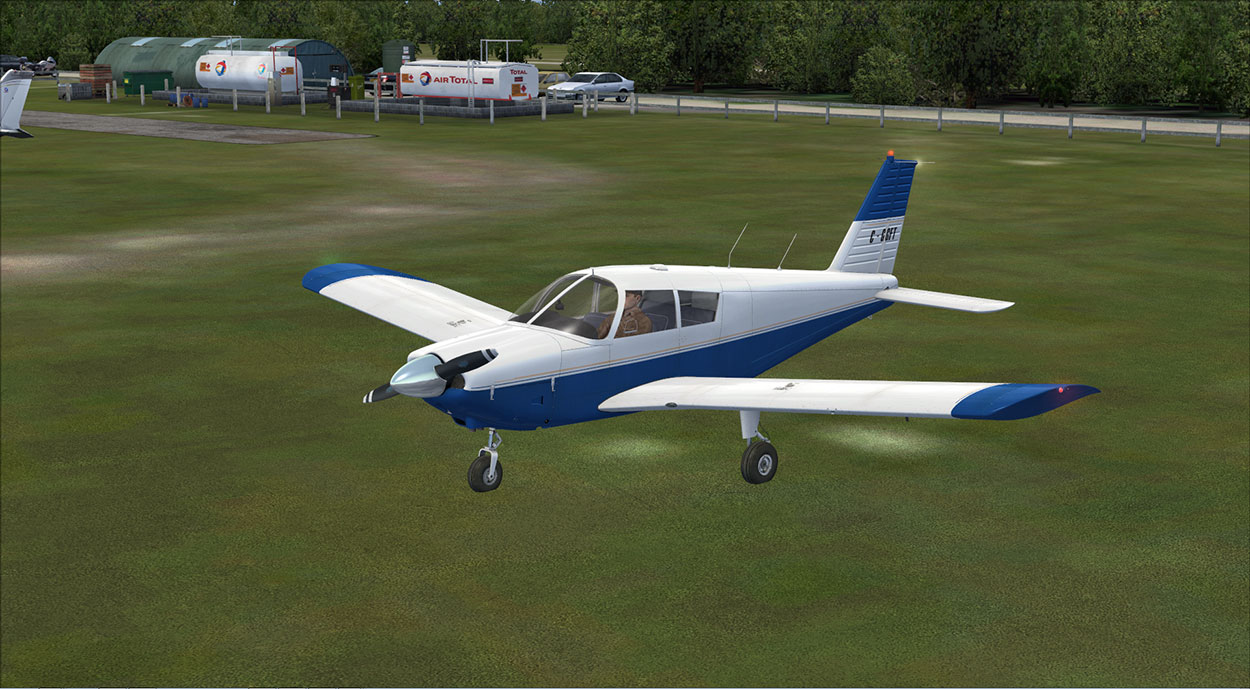 White-Blue |
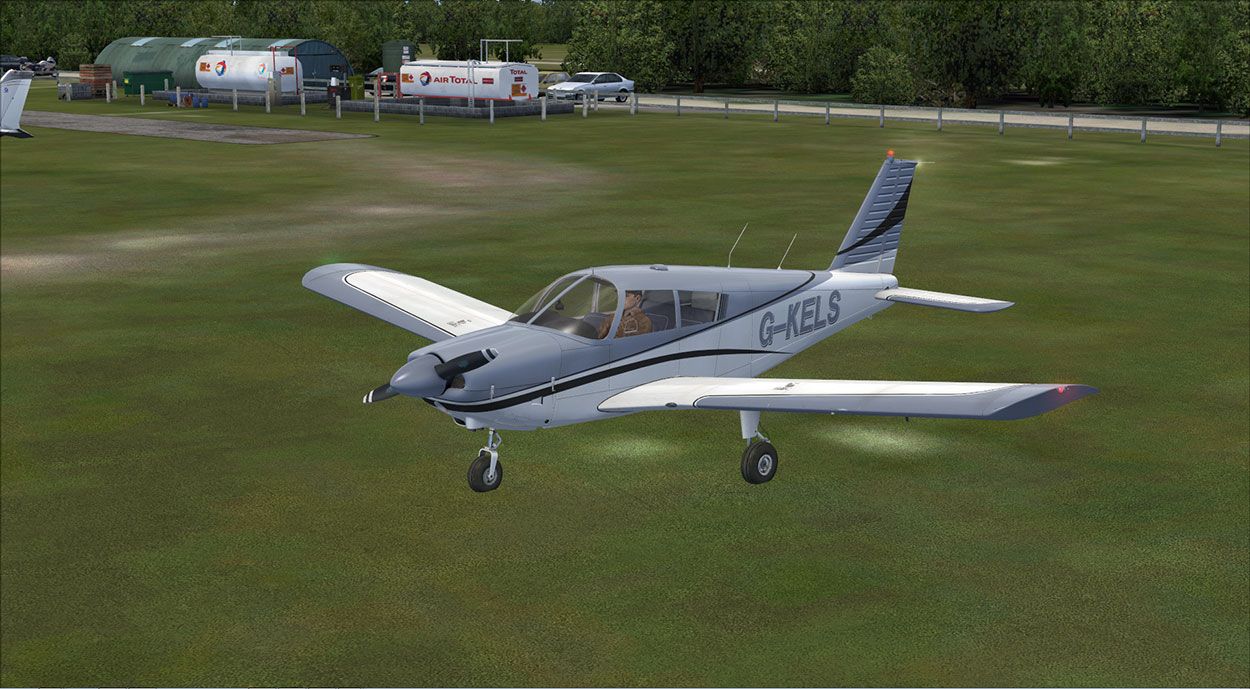 White-Grey |
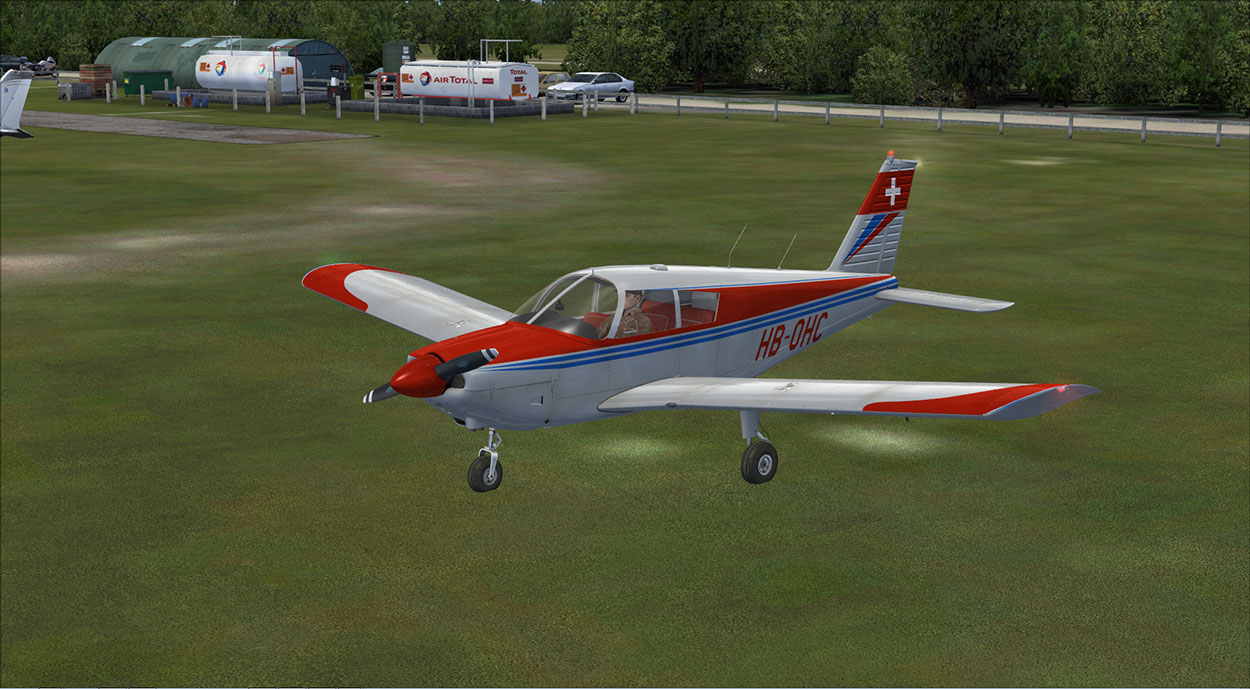 Silver-Red-Blue |
|
Visual Appearance
Exterior - The A2A Simulations Cherokee has a polished external appearance. When looking to the texture files we can see that they have supplied the textures in 4096 * 4096 DXT5 .dds format so you wouldn't get any better. From a distance the low wing dihedral is very noticeable, at 7° it is twice that of a high wing aircraft such as the C172.
Exterior - The A2A Simulations Cherokee has a polished external appearance. When looking to the texture files we can see that they have supplied the textures in 4096 * 4096 DXT5 .dds format so you wouldn't get any better. From a distance the low wing dihedral is very noticeable, at 7° it is twice that of a high wing aircraft such as the C172.
The accuracy of all the external features are near perfect. The rudder has deep furrows and aerials which can clearly be seen below and note the all in one 'stabilator' at full deflection with the trailing edge automatically moving to compensate.
The Walk Around - As part of preparing to fly,
you perform the walk around - this ensures that all the external
devices such has pitot covers tie downs and chocks have been removed
along with checking the condition of hinges a and links. This gives
you more evidence of how the externals look close up.
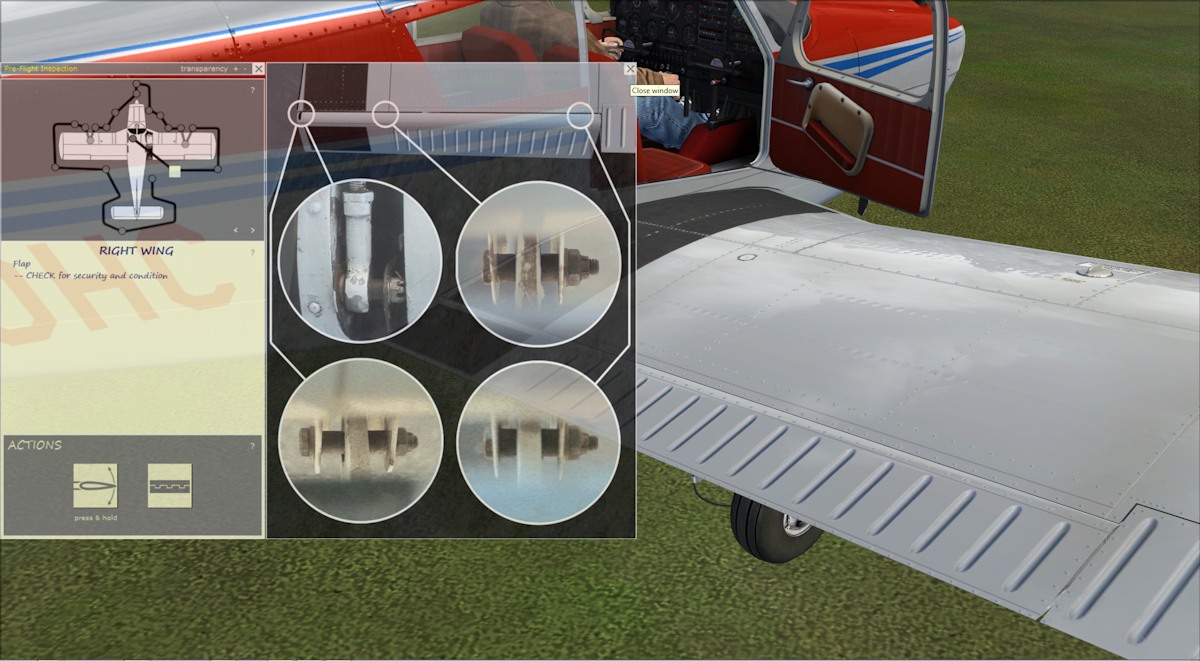 Checking for security and condition |
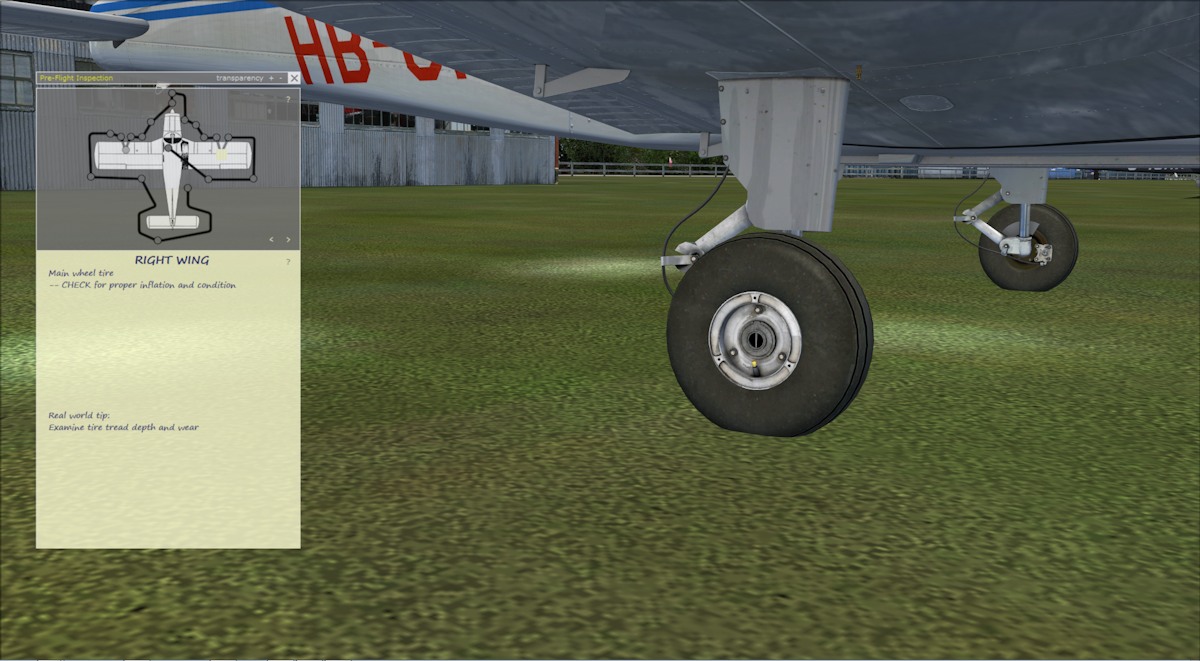 Examine tyre tread depth and wear |
 Visual check for desired fuel level |
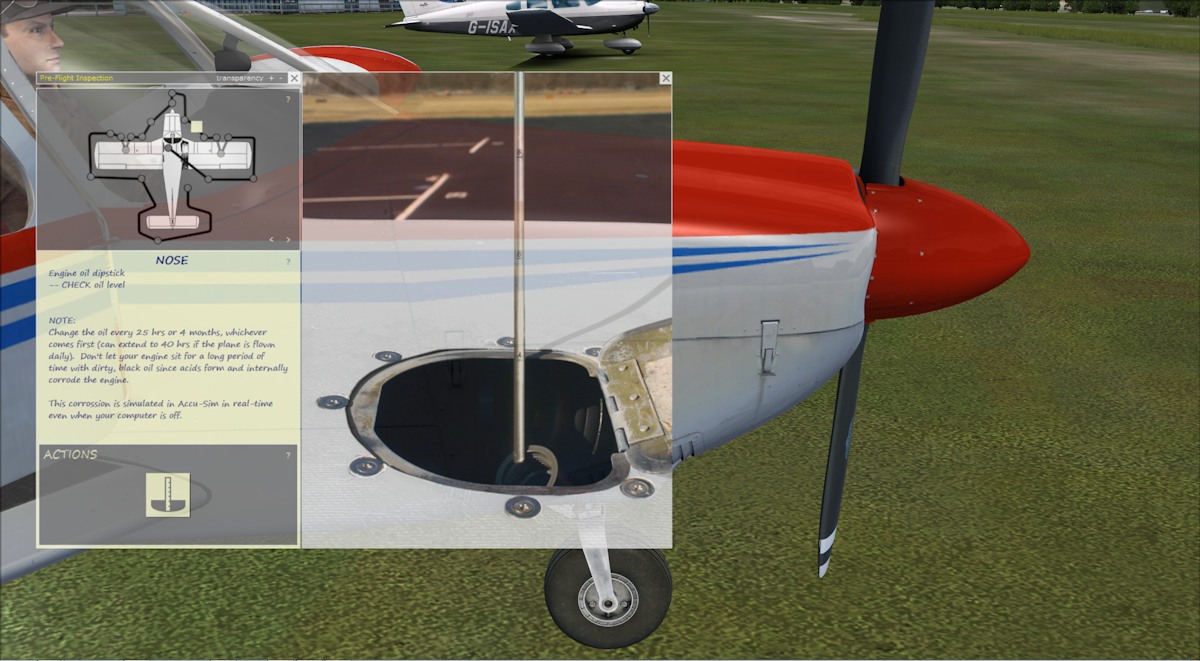 Check the engine oil |
 Inspect fuel |
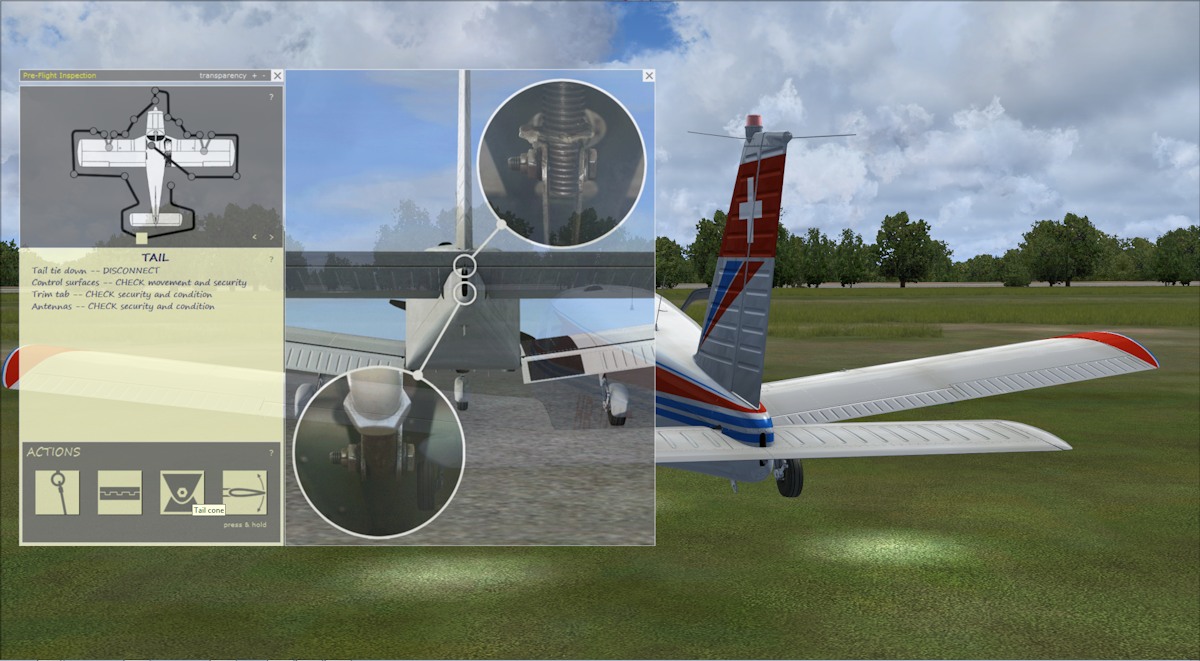 Check the tail |
Interior - The interior
appearance is of a very high quality. It is easy to see that
a lot of care has been taken in the finish and operation of
very switch and gauge. The yokes can be individually hidden
to gain easier access to the switches behind them. Around
some of the switches, the starter button, as you would
expect, for example show
wear and tear. The panel itself is a
little scuffed but generally in much better than any real world
cockpit I have been in.
Cabin - The cabin is pretty much as you
would expect it to be, a bench seat with stowage behind, on
the ceiling is the dome light and animated cabin ventilation
controller.
Lighting - Internally, the gauges have two
levels of brightness and off, they can also be externally
illuminated by a red spotlight, the dome light or both. The Bendix King
avionics stack has
authentic period LEDs with each having a different delay
when illuminating after the avionics master switch is turned
on.
On the exterior, the 3D navigation lights are superbly
presented with the landing light having that A2A proprietary
glow that looks so good.
Sounds and Animations
The sound system with the A2A Cherokee 180 is one of the most complete I have experienced. Every switch has an eager click sound, even when opening the circuit breakers you get a sound. The VC also has many animations that are synchronised to the sounds. I have taken a short video of some of the VC sounds and and animations below.
 VC - General view |
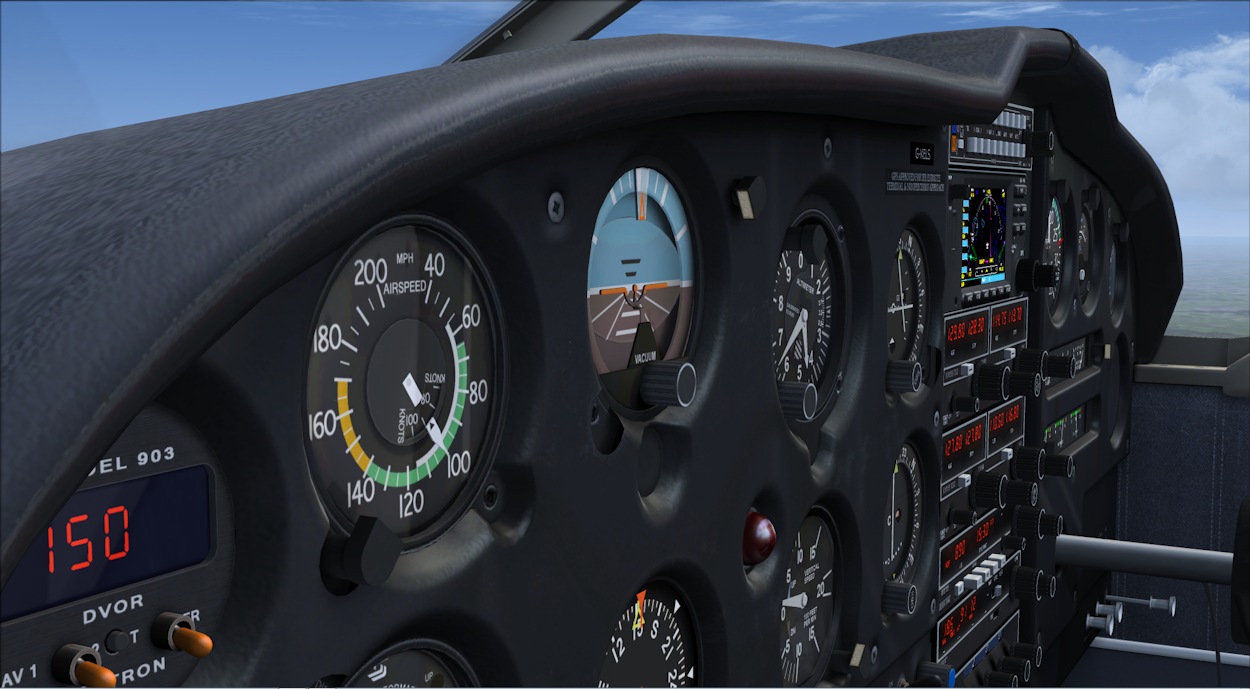 VC - A real 3D feel |
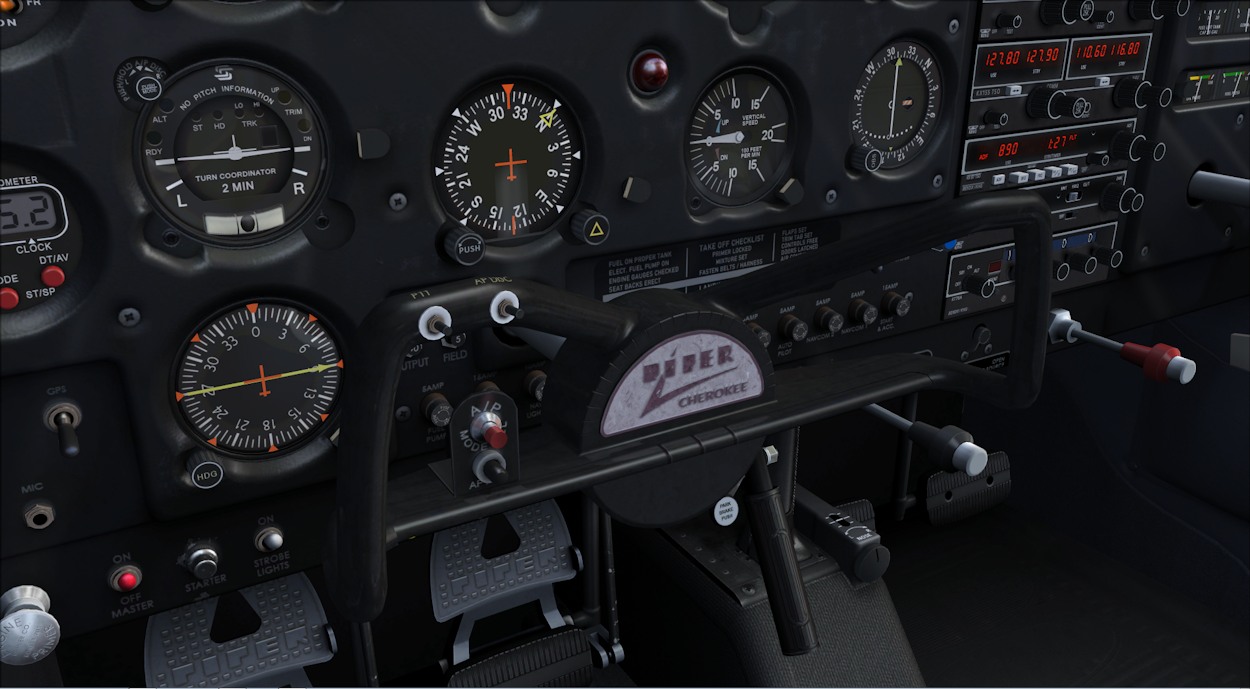 With yoke - Notice reflection of the yoke shaft in heading gauge |
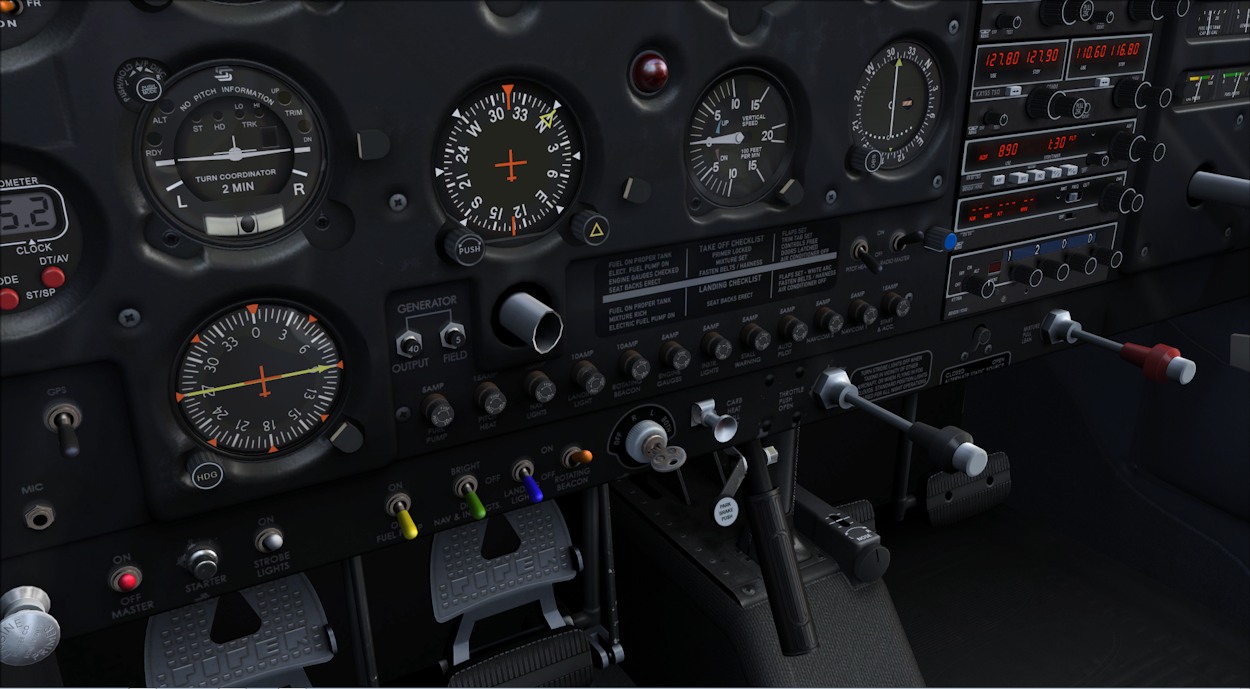 Without Yoke - Yoke shaft reflection gone |
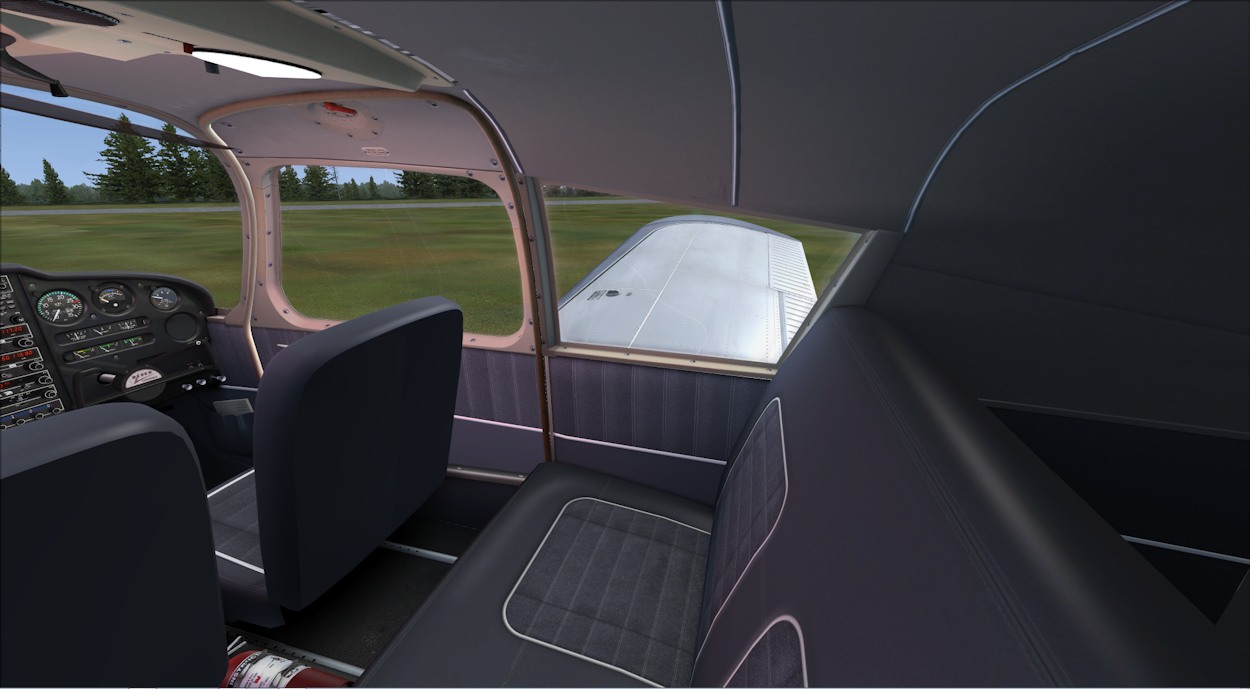 From the rear |
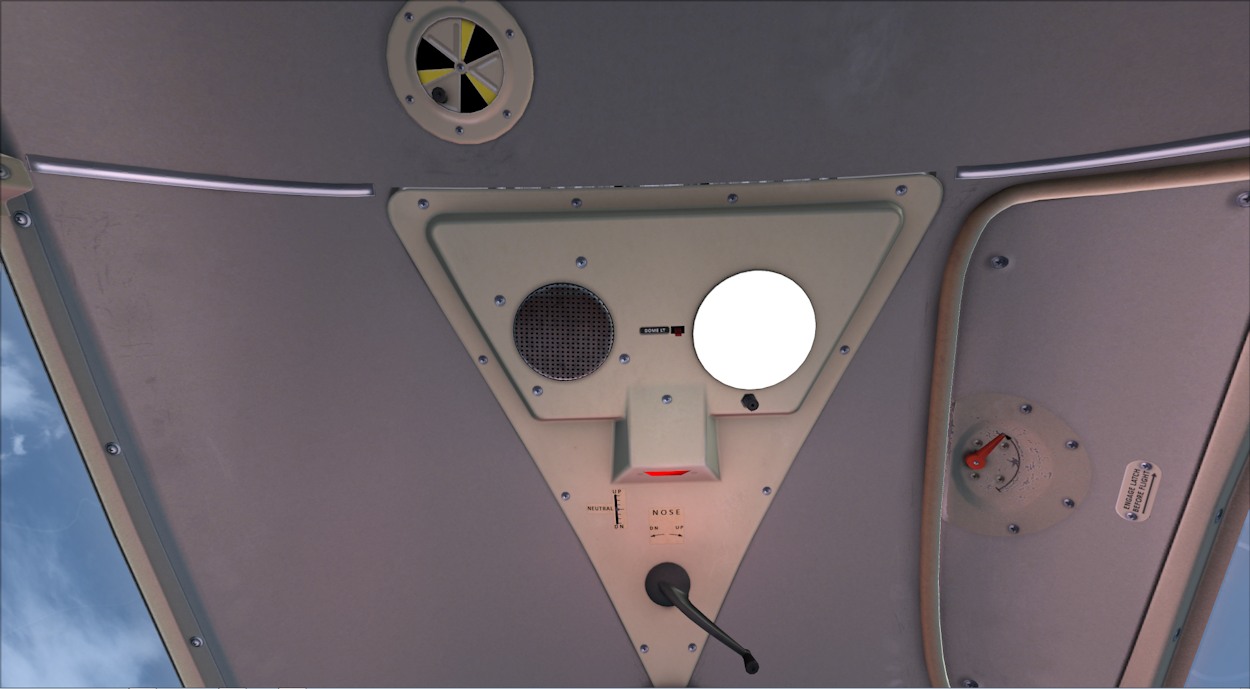 Cabin ceiling |
 Various levels of cockpit lighting |
 Exterior lighting |
The sound system with the A2A Cherokee 180 is one of the most complete I have experienced. Every switch has an eager click sound, even when opening the circuit breakers you get a sound. The VC also has many animations that are synchronised to the sounds. I have taken a short video of some of the VC sounds and and animations below.
One feature I really like in the VC is plugging in the headphones. If like me, you use VoxATC or an on-line resource for your traffic control, then plugging in the headphones in the VC reduces the sound of the engines through your headphones (if you are wearing them). This makes communicating with the controller is so much easier. If you are not wearing headphones then the action of plugging them in merely reduces the engine sound on your speakers. This is a far handier way to control the cockpit sounds.
Externally, the sound effects are fairly standard albeit with enhanced engine sounds. On touch down you will get tyre screech and brake squeal depending on how hard you press the brake pedals. The control surface animations look fairly standard but on closer view of the moving parts you will notice how smooth and accurate they are, even the pitot cover swings in the wind when cold and dark.
General Characteristics and Performance Specifications

Accu-Sim (My take on it) - How many times have you sat behind the yoke thinking what you are flying has no soul? A sterile flying environment where the numbers coming back from the dials give you the statistics, but without feeling. How many times have you flown knowing that there are never really any consequences from your actions? The temperatures and pressures which you are not monitoring are running in the red zone... but you will be ok. Or maybe flying this PA28 Cherokee is just the same as flying that PA24 Comanche? To me, that is a hollow simming experience.
At the very core of this simulation beats the heart of Accu-Sim. As the name suggests this is an abbreviation for Accurate Simulation. The core ESP engine behind FSX and P3D has many limitations when it comes to flight modelling and dynamics. Accu-Sim brings a living aircraft to your ownership, how you treat the aircraft is not forgotten as the Cherokee 180 is a persistent model, if you left it with no oil and fouled plugs last time, that's just how it will be when you load the aircraft next time.
Flying with Accu-sim is all about full system modelling, from the heat of the air entering the carb, to the heat in the cockpit causing the windshield to steam up. No two situations are the same, take over-heating the engine for example, one time this may result in a fire, the next time it may just run smoothly or just quit. Even landings are monitored and you will get a sickening metal crunching sound if you drop it on the ground.
So let's take her for a flight, assuming pre-flight checks have been done, see below.
 Check list and other set up |
 It also has a built-in map |
The gauges each have their own way of running, be it air pressure, suction or mechanical. The rev counter my fluctuate at certain times due to mechanical slack, needles vibrate and gyros fluctuate when starting. Embarrassingly, I thought the ASI had broken until I realised the pitot cover was still on! Why did that happen? Because I didn't do a complete walk around and it resulted in me abandoning a take off run, much to the enjoyment of the lads in the flying club!
Happy that the T&P's (temperatures and pressures) are acceptable we can perform our power checks on the taxiway pointing away from the runway. Running the engine at 2000 RPM and switching the magnetos and turning the carb heat on and off should result in a small loss of of RPM, and it does, just like the real thing. Whilst running the engine up, the cockpit will shake, rattle, and roll.
At sea level, the take off roll with 1 notch of flap is around 800ft, you can take 10% off that distance using full flap and maximum effort. At just over 60kts she will ease herself off the ground, with speed building to around 90 and flaps retracted, pulling back on the yoke will give you tremendous lift. Maintaining at least 75knots will give you the best angle of climb but keeping to a speed of 85kts will give you the best rate of climb. The figures quoted in the manual are easily achievable whilst maintaining that bit extra in case of emergency.
 Climbing out |
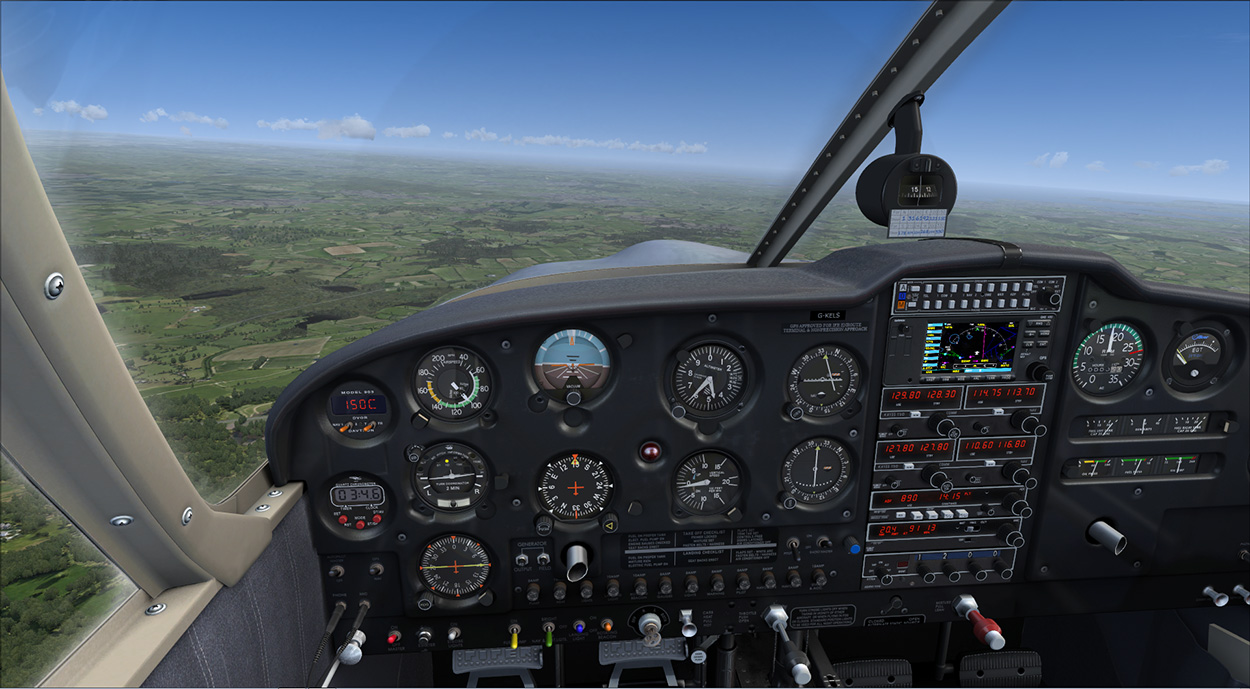 Cruising and following the inbound 150 radial to GWC |
The aircraft has quite a steady low roll rate thanks to the dihedral of the wings, this means that as one wing lowers it achieves more lift than the higher wing, so tends to cause a self leveling effect. As you are chugging along she is very stable, even in turbulence keeping her straight and level was not too much a challenge. However, if you want to roll her fast, the large ailerons will flip her around quite rapidly. Trimming appears to be a lot more immediate than when flying a similar aircraft. This is due to the rear horizontal stabilizer moving in its entirety rather than having a hinged elevator. This is what they call a stabilator again, the manual will give you a full explanation with diagrams.
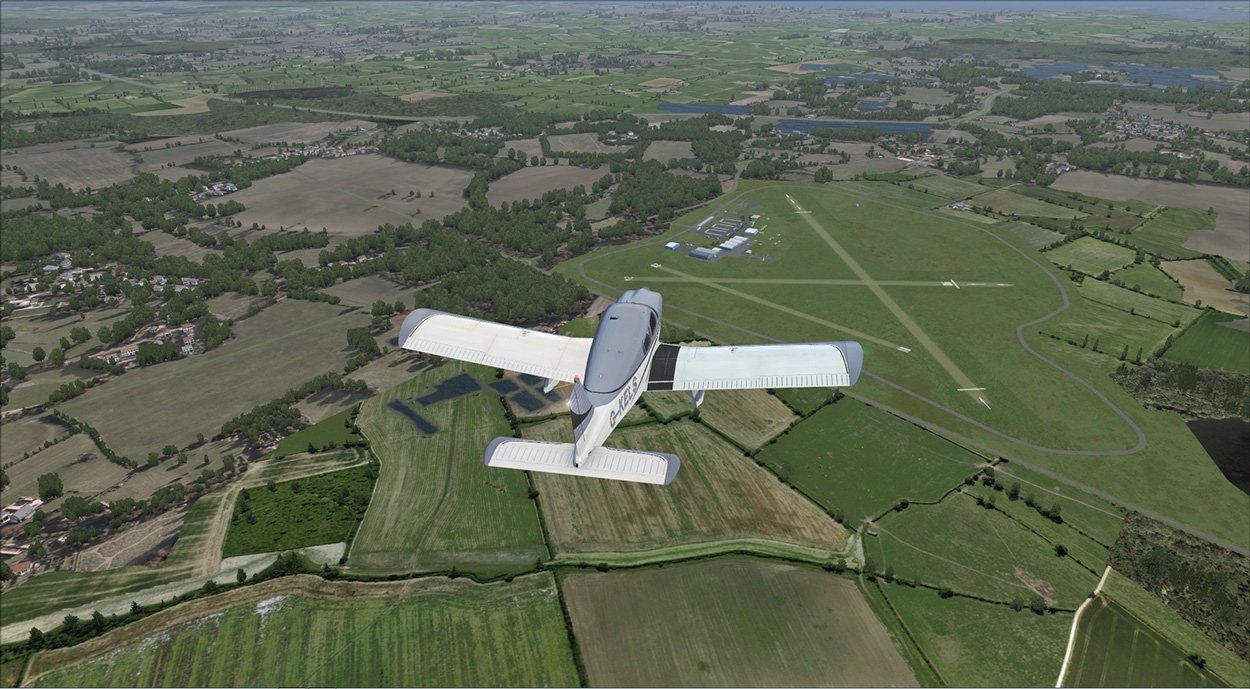 Almost overhead Goodwood VOR |
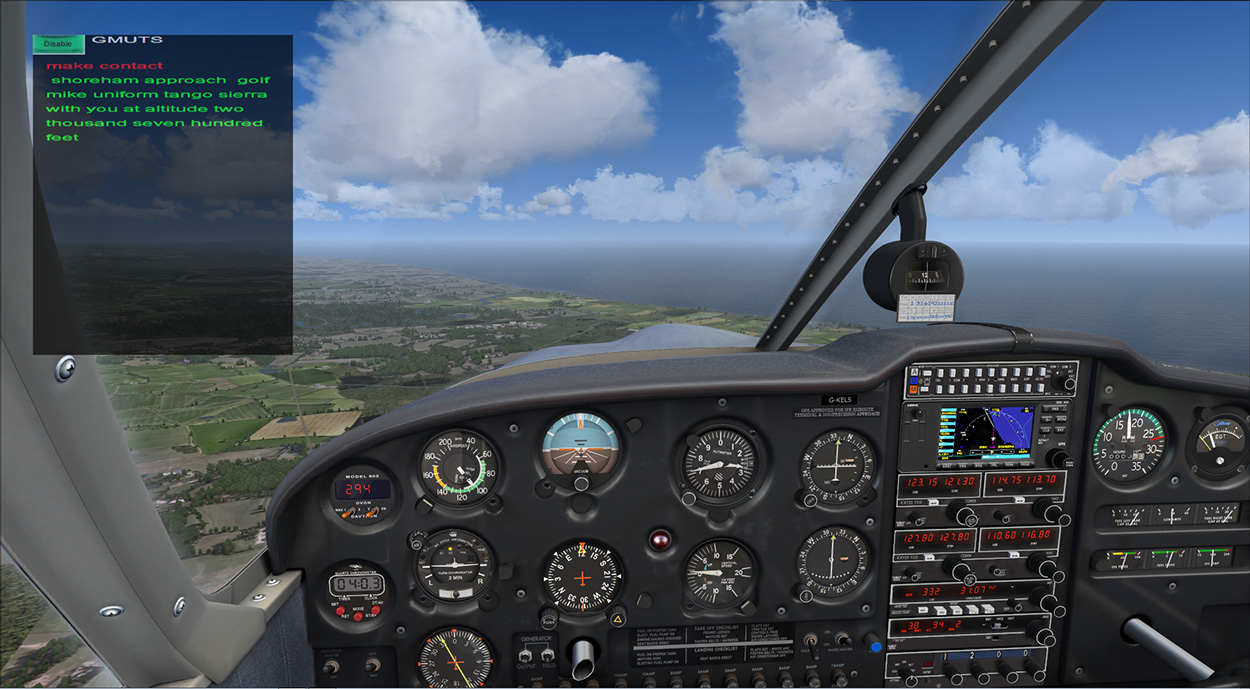 Using VoxATC to contact Shoreham |
 Recovering from stall |
 On final for Shoreham runway 02 |
So does she fly by the numbers? Yes, well within tolerance and with feeling. She looks and feels a bit cumbersome but she is reliable, just like the low- wing wonder I flew in the real world just a few weeks ago.
Value For Money
Further to the pricing structure shown above, for simmers who only want the version for their simulator type (FSX or P3Dv2 Academic), then the price of $49.99 is comparable with previous Accu-Sim bundles, the P40 for example comes in at $49.98 and the B17 II at $62.98.
If you want to be future proofed then the combined pack (FSX and P3Dv2 Academic), will cost you 20 US Dollars more at $69.99. At for this price you get two standalone versions of the product with their own installers and licenses.
Things get a lot more pricy for P3D Professional and Commercial users. The price differences, they say, are due to product usage type, the P3D Professional version will be used more frequently than the Academic or FSX Entertainment version, but the product is essentially the same. This is just a high-level overview from me and I am sure there are many arguments for them adopting the Lockheed Martin licensing/ pricing structure.
Technical Requirements
The A2A Accu-Sim Cherokee 180 is for FSX / P3D only. Other specified technical requirements are as follows:
● Windows XP with SP3 installed, Windows Vista or Windows 7 (32 or 64 bit), Windows 8 & 8.1;
● Microsoft Flight Simulator FSX with SP1 and SP2 (or Acceleration Pack) or Lockheed Martin Prepar3d Flight Simulator installed; and
● 2.0 GHz single core processor (3.0GHz and/or multiple core processor or better recommended), minimum 2GB RAM (4GB recommended),
512MB graphics card, and 250MB available HDD space.
Simulator Performance
The aircraft model performed very well within the existing settings I have in FSX. I have most of my settings set very high and there was no need to make any adjustments. FSX continued to perform smoothly and as it would with any default aircraft.
Review Computer Specifications
The specifications of the computer on which the review was conducted are as follows:
● Intel i7 4770K Extreme 4.2GHz;
● NVidia GTX690, 4096MB graphics;
● 16GB Corsair DDR3 1866MHz;
● Windows 7, (64bit);
● Microsoft Flight Simulator FSX Acceleration; and
● + Additional major add-ons include Active Sky Next, REX Textures, Orbx FTX and Ultimate Traffic 2.
Conclusion
The A2A Simulations Accu-Sim Cherokee 180 is a well researched and well developed aircraft simulation. It teaches us that you cannot take short cuts when flying by the book otherwise there will be consequences.
Flying this aircraft is pure joy and I would heartily recommend it to anyone interested in single engined GA aircraft training.
Pros
● High quality and attention to detail;
● Excellent animations and sound effects;
● Realistic modelling and performance; and
● Excellent user manual.
Cons
● Combination pack over priced.
Product Link
AccuSim Cherokee
| Verdict: |  | |
| ● External Model: | 10/10 | |
| ● Internal Model: | 10/10 | |
| ● Sounds: | 10/10 | |
| ● Flight Characteristics (does it fly by the numbers): | 10/10 | |
| ● Flight Dynamics (does it feel like what it looks like): | 10/10 | |
| ● Documentation: | 10/10 | |
| ● Value for Money: | 9.5/10 |
| A2A Simulations' Accu-Sim
Cherokee 180 is awarded a Mutley's Hangar score of 9.9/10, "Outstanding"
and a Mutley's Hangar Gold Award. |




